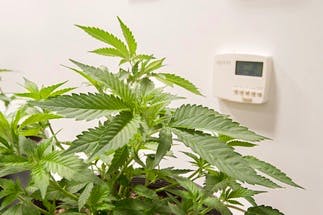The Fundamentals of Humidity for your Cannabis Grow Room
It’s no secret that understanding relative humidity (RH) — and how to control it — is key for any commercial cultivator looking to produce quality cannabis. No matter the size of your grow, it starts with understanding the basics.
It’s essential to be in tune with humidity levels in your grow room because ideal RH varies with each phase of growth. If you’re unaware of humidity changes that occur when you turn your grow room lights on and off, you’ll face challenges like diseases and pests.
Relative Humidity: Why it’s Important to Understand RH in your Cannabis Grow
For starters, let’s define relative humidity (RH) as the percentage of how much moisture is in the air versus how much the air could hold. It’s relative to temperature because air saturation is dependent on moisture content and temperature.
For growers, this means RH increases and decreases depending on grow room temperature. RH and temperature have an inverse relationship, so when the temperature in your grow room raises, humidity lowers, and vice versa.
Retzlaff said that, at the very least, every grower should have a temperature and humidity gauge in their grow room to monitor trends and make any necessary proactive adjustments.
Relative Humidity at Each Stage of Cannabis Growth
In the beginning of the plant cycle, when plants are clones or seedlings, they don’t have developed root systems for water transfer. Many growers maintain a higher RH during this stage since moisture in the air is the plants’ primary water source.
Mike Steffes, a lab scientist with Quest’s research and design team, has worked with cannabis for over 20 years. He recommends the following humidity levels:
Clones – high humidity (60 to 80 percent RH)
- Veg – start to decrease humidity (50 to 60 percent RH)
- Flowering – a bit dryer (40 to 55 percent)
- Late flower – even dryer (40 to 50 percent)
As with many techniques in the cannabis industry, optimal humidity is up for debate because growers have their own comfort areas and preferences. However, the best cultivators agree humidity control is a chief component of successful grows.
“The more you read, the more opinions you gain and the better off you’re going to be,” Retzlaff said. “For every 10 articles you read, you’ll get 10 opinions, but more importantly you’ll find commonalities that you can apply to your operations.”
Monitor Relative Humidity after your Cannabis Grow room Lights Turn On and Off
“Monitoring RH throughout the light and dark cycles is important so you can keep everything under control and make any changes to protect your crops,” Steffes said.
During the day and night cycles, temperature and humidity fluctuate. At night, humidity increases when the lights turn off due to temperature decrease. When you turn the lights on in the morning humidity drops due to increased temperature.
Ideally, it’s helpful to have a meter that logs data so you can detect trends over time, but not all operations have the means to purchase advanced technology. If digital technology is more than you need, simply measure RH with a humidity reader and pay attention to changes, noting the highs and lows.
“Even if you’re not recording data, you can get a good intuitive feel for what’s happening in your grow,” Steffes said. “All you need to do is take the time to spot check with a handheld meter and observe your plants daily.”
If humidity gets too low, adjust your dehumidifier or temperature, and if the humidity is too high, it’s time to think about humidity control. Dehumidifiers are useful grow room additions because they allow you to make adjustments based on your specific climate and operation needs.
Vapor pressure deficit
The concept works when growers adjust relative humidity and temperature at appropriate life stages to optimize nutrient intake and growth, and it’s measured with charts or calculations.
For the basics, you need to know that a high VPD number means the air is mostly dry, while a low VPD number means the air is close to saturation.
Fortunately, there’s a growing number of resources out there on the subject for those who are interested in learning more.
Why Air Circulation Protects Your Crops
Air movement is crucial because it circulates carbon dioxide (CO2), cool air and prevents grow rooms from becoming stagnant. Fans, or commercial air movers, are great tools to use in your operations because they keep the air circulating, which helps fight fungal attacks.
Air circulation is especially important when you transition from a light to a dark cycle because the temperature decreases and RH increases after the hot lights shut off. Fans prevent moisture from condensing on leaves, which would otherwise appear like dew and subject your plants to mold and mildew.

